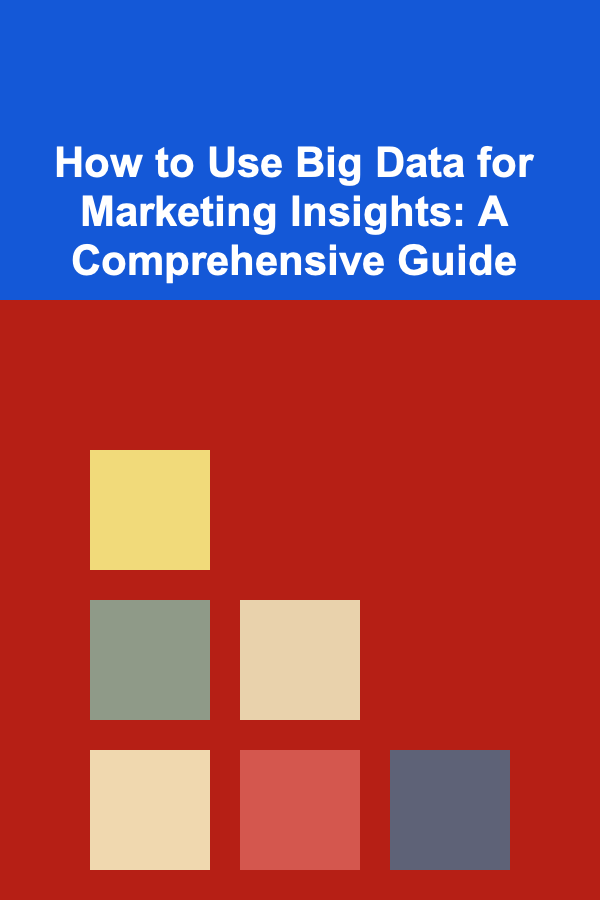
How to Use Big Data for Marketing Insights: A Comprehensive Guide
ebook include PDF & Audio bundle (Micro Guide)
$12.99$11.99
Limited Time Offer! Order within the next:

In today's digital age, marketing has transformed from a guessing game into a data-driven science. The sheer volume, velocity, and variety of data available -- often referred to as "big data" -- presents unparalleled opportunities for marketers to understand their audience, optimize campaigns, and drive business growth. However, simply possessing this data is not enough. The key lies in effectively harnessing big data to extract actionable marketing insights.
Understanding Big Data and Its Relevance to Marketing
Big data is characterized by the three Vs (and sometimes more):
- Volume: The massive amount of data generated every second from various sources like social media, website traffic, online transactions, and sensor data.
- Velocity: The speed at which data is generated and processed. Real-time data streaming requires rapid analysis and decision-making.
- Variety: The different types of data available, including structured data (e.g., databases), unstructured data (e.g., text, images, video), and semi-structured data (e.g., log files).
- Veracity: The trustworthiness and accuracy of the data. Dealing with noisy or incomplete data is a common challenge.
- Value: The potential business benefits derived from analyzing and interpreting the data. The ultimate goal is to extract meaningful insights that lead to improved marketing outcomes.
For marketers, big data offers a wealth of information about:
- Customer Behavior: Understanding customer preferences, buying patterns, online activity, and interactions with brands.
- Market Trends: Identifying emerging trends, shifts in consumer demand, and competitive landscapes.
- Campaign Performance: Measuring the effectiveness of marketing campaigns, optimizing ad spend, and improving ROI.
- Personalization: Delivering tailored messages and experiences to individual customers based on their unique needs and interests.
- Predictive Analytics: Forecasting future trends, anticipating customer needs, and proactively addressing potential issues.
Sources of Big Data for Marketing
The first step in leveraging big data is identifying the relevant data sources. These sources can be broadly categorized as follows:
1. Website Analytics
Website analytics platforms like Google Analytics and Adobe Analytics provide valuable data about website traffic, user behavior, and conversion rates. This data can be used to:
- Identify popular content and landing pages.
- Understand user demographics and interests.
- Track the customer journey from initial visit to conversion.
- Optimize website design and user experience.
- Identify drop-off points in the conversion funnel.
Advanced website analytics tools can also track user behavior through heatmaps, session recordings, and A/B testing, providing deeper insights into how users interact with the website.
2. Social Media Analytics
Social media platforms generate vast amounts of data about user demographics, interests, opinions, and interactions. Social media analytics tools can be used to:
- Monitor brand mentions and sentiment.
- Identify influential users and brand advocates.
- Track engagement with social media posts and campaigns.
- Understand customer conversations and emerging trends.
- Identify potential customer service issues.
Social listening tools can also be used to monitor social media conversations for relevant keywords and topics, providing valuable insights into customer needs and pain points.
3. Customer Relationship Management (CRM) Systems
CRM systems like Salesforce, HubSpot, and Microsoft Dynamics 365 store valuable data about customer interactions, purchase history, and demographics. This data can be used to:
- Segment customers based on their characteristics and behavior.
- Personalize marketing messages and offers.
- Track customer lifetime value.
- Identify opportunities for upselling and cross-selling.
- Improve customer service and support.
Integrating CRM data with other data sources, such as website analytics and social media data, can provide a more complete view of the customer.
4. Email Marketing Platforms
Email marketing platforms like Mailchimp and Constant Contact track email open rates, click-through rates, and conversion rates. This data can be used to:
- Optimize email subject lines and content.
- Segment email lists based on subscriber behavior.
- Personalize email messages based on subscriber preferences.
- Test different email formats and layouts.
- Improve email deliverability.
Email marketing data can also be used to track the effectiveness of lead nurturing campaigns and identify opportunities to improve lead conversion rates.
5. Online Advertising Platforms
Online advertising platforms like Google Ads and Facebook Ads Manager provide detailed data about ad impressions, clicks, and conversions. This data can be used to:
- Optimize ad targeting based on demographics, interests, and behavior.
- Track the performance of different ad creatives and placements.
- Manage ad budgets effectively.
- Identify high-performing keywords and audiences.
- Improve ad quality scores and reduce cost per acquisition.
Attribution modeling can be used to determine the contribution of each ad touchpoint to the overall conversion process.
6. Point of Sale (POS) Systems
POS systems used in retail stores and restaurants track sales transactions, product inventory, and customer purchases. This data can be used to:
- Identify popular products and services.
- Track sales trends over time.
- Manage inventory levels effectively.
- Identify customer segments based on their purchasing behavior.
- Optimize pricing and promotions.
Loyalty programs can be integrated with POS systems to collect data about customer demographics and preferences, enabling personalized marketing and promotions.
7. Mobile App Analytics
Mobile app analytics platforms track user behavior within mobile apps, including app usage, feature adoption, and in-app purchases. This data can be used to:
- Understand how users interact with the app.
- Identify areas for improvement in the user interface and user experience.
- Track user retention and churn rates.
- Personalize in-app messaging and offers.
- Optimize app monetization strategies.
Push notifications can be used to re-engage users and drive app usage based on their behavior and preferences.
8. IoT (Internet of Things) Data
IoT devices, such as smart sensors and connected appliances, generate vast amounts of data about the physical world. This data can be used to:
- Track environmental conditions and usage patterns.
- Optimize resource allocation and efficiency.
- Predict equipment failures and schedule maintenance.
- Personalize customer experiences based on real-time data.
- Develop new products and services based on customer needs.
For example, a smart thermostat can collect data about temperature settings and usage patterns to optimize energy consumption and provide personalized comfort recommendations.
Steps to Extract Marketing Insights from Big Data
Once you have identified the relevant data sources, the next step is to extract actionable marketing insights. This process typically involves the following steps:
1. Data Collection and Integration
The first step is to collect data from all relevant sources and integrate it into a central data warehouse or data lake. This requires:
- Identifying the data sources that are relevant to your marketing goals.
- Implementing data collection mechanisms to capture data from those sources.
- Ensuring data quality and accuracy.
- Integrating data from different sources into a unified data repository.
Data integration can be a complex process, especially when dealing with data from different sources and formats. Data warehousing and ETL (Extract, Transform, Load) tools can be used to automate this process.
2. Data Cleaning and Preparation
Raw data is often incomplete, inconsistent, and noisy. Therefore, it is essential to clean and prepare the data before analysis. This involves:
- Removing duplicate records.
- Filling in missing values.
- Correcting errors and inconsistencies.
- Standardizing data formats.
- Transforming data into a suitable format for analysis.
Data cleaning and preparation can be a time-consuming process, but it is crucial for ensuring the accuracy and reliability of the analysis results.
3. Data Analysis and Exploration
Once the data is cleaned and prepared, the next step is to analyze and explore the data to identify patterns, trends, and relationships. This can be done using a variety of techniques, including:
- Descriptive Statistics: Calculating summary statistics like mean, median, mode, and standard deviation to understand the distribution of the data.
- Data Visualization: Creating charts, graphs, and dashboards to visualize data patterns and trends.
- Segmentation Analysis: Grouping customers into segments based on their characteristics and behavior.
- Correlation Analysis: Identifying relationships between different variables.
- Regression Analysis: Predicting the value of one variable based on the value of other variables.
Data analysis tools like R, Python, and Tableau can be used to perform these analyses.
4. Insight Generation and Interpretation
The next step is to interpret the analysis results and generate actionable marketing insights. This involves:
- Identifying the key findings from the analysis.
- Understanding the implications of these findings for your marketing strategy.
- Developing hypotheses and testing them with further analysis.
- Translating the findings into actionable recommendations.
This step requires strong analytical skills and a deep understanding of your business and your customers.
5. Action and Implementation
The final step is to implement the recommendations and measure the results. This involves:
- Developing a plan for implementing the recommendations.
- Assigning responsibilities and setting deadlines.
- Monitoring the results and making adjustments as needed.
- Tracking the ROI of your marketing initiatives.
It's crucial to track the performance of implemented changes and make adjustments as needed to ensure optimal results. This is an iterative process of data collection, analysis, insight generation, action, and measurement.
Specific Marketing Applications of Big Data Insights
Big data insights can be applied to a wide range of marketing activities:
1. Personalized Marketing
Big data allows marketers to deliver personalized experiences to individual customers based on their unique needs and interests. This includes:
- Personalized email marketing with tailored content and offers.
- Personalized website content based on user behavior and preferences.
- Personalized product recommendations based on past purchases.
- Personalized advertising based on demographics, interests, and online activity.
By delivering personalized experiences, marketers can increase customer engagement, improve conversion rates, and build stronger customer relationships.
2. Improved Customer Segmentation
Big data enables marketers to segment their customers more effectively based on a wide range of factors, including demographics, behavior, purchase history, and psychographics. This allows them to:
- Target marketing messages more effectively to specific customer segments.
- Develop products and services that meet the needs of specific customer segments.
- Optimize pricing and promotions for different customer segments.
- Improve customer acquisition and retention rates.
Advanced segmentation techniques like cluster analysis and machine learning can be used to identify hidden customer segments and personalize marketing strategies accordingly.
3. Enhanced Customer Journey Mapping
Big data helps marketers understand the customer journey across different touchpoints, from initial awareness to purchase and beyond. This allows them to:
- Identify the key touchpoints that influence the customer's decision-making process.
- Optimize the customer experience at each touchpoint.
- Identify and address pain points in the customer journey.
- Improve customer satisfaction and loyalty.
Customer journey analytics tools can be used to visualize the customer journey and identify opportunities for improvement.
4. Predictive Analytics for Marketing
Big data can be used to predict future trends, anticipate customer needs, and proactively address potential issues. This includes:
- Predicting customer churn and taking steps to prevent it.
- Forecasting demand for products and services.
- Identifying potential leads and targeting them with personalized marketing messages.
- Predicting the outcome of marketing campaigns.
Predictive analytics techniques like machine learning and time series analysis can be used to build predictive models.
5. Real-time Marketing Optimization
Big data allows marketers to monitor campaign performance in real-time and make adjustments as needed. This includes:
- Optimizing ad bids based on real-time performance data.
- Personalizing website content based on real-time user behavior.
- Sending triggered emails based on real-time events.
- Adjusting marketing campaigns based on real-time customer feedback.
Real-time marketing optimization requires a robust data infrastructure and advanced analytics capabilities.
Challenges and Considerations
While big data offers tremendous opportunities for marketers, there are also several challenges and considerations to keep in mind:
- Data Privacy and Security: Protecting customer data and complying with privacy regulations like GDPR and CCPA is paramount.
- Data Quality: Ensuring the accuracy and reliability of data is crucial for making informed decisions.
- Data Complexity: Managing and analyzing large volumes of diverse data can be challenging.
- Skills Gap: A shortage of skilled data scientists and analysts can hinder the ability to extract meaningful insights from big data.
- Cost: Implementing and maintaining a big data infrastructure can be expensive.
- Integration Challenges: Integrating data from different sources can be technically complex and time-consuming.
- Ethical Considerations: Using data responsibly and ethically is crucial for maintaining customer trust and avoiding negative consequences. This includes avoiding biased algorithms and ensuring transparency in data collection and usage practices.
Addressing these challenges requires a comprehensive approach that includes investing in data governance, training employees, and implementing robust security measures.
Conclusion
Big data offers a powerful toolkit for marketers seeking to gain a deeper understanding of their customers, optimize campaigns, and drive business growth. By effectively collecting, analyzing, and interpreting big data, marketers can unlock valuable insights that lead to more personalized, targeted, and effective marketing strategies. While challenges exist, the potential rewards of leveraging big data for marketing insights are significant. Embracing a data-driven approach is no longer a luxury but a necessity for success in today's competitive marketplace. Investing in the right tools, talent, and processes will enable marketers to harness the power of big data and achieve their marketing objectives.
Reading More From Our Other Websites
- [Home Soundproofing 101] How to Block Out Noises from the Outside with Simple Techniques
- [Home Security 101] How to Secure a Home with a Pool: Essential Tips for Pool Safety
- [Home Family Activity 101] How to Create a Family "Bucket List"
- [Home Cleaning 101] How to Establish an Effective Bathroom Cleaning Routine for a Hygienic Home
- [Organization Tip 101] How to Make Use of Under-Bed Storage for Pet Supplies
- [Rock Climbing Tip 101] How to Set Up a Self‑Rescue System on Single‑Pitch Trad Routes
- [Home Staging 101] How to Stage a Small Apartment to Look Bigger
- [Personal Care Tips 101] How to Use a Toothbrush to Clean Your Tongue and Improve Freshness
- [Whitewater Rafting Tip 101] Paddles, Power, and Purpose: Turning Rafting Adventures into a Blueprint for a New Life
- [Home Maintenance 101] How to Ensure Your Home's Plumbing is Winter-Ready

Effective Techniques for Negotiating for Lower Prices and Saving Big
Read More
How to Choose the Right Vet for Your Pet
Read More
How to Protect Your Rental Property from Property Damage
Read More
The Art of Architecture: Techniques for Creating Sustainable and Aesthetic Designs
Read More
How To Take Engaging Candid Shots
Read More
Mastering Guitar Picking Techniques: A Comprehensive Guide
Read MoreOther Products

Effective Techniques for Negotiating for Lower Prices and Saving Big
Read More
How to Choose the Right Vet for Your Pet
Read More
How to Protect Your Rental Property from Property Damage
Read More
The Art of Architecture: Techniques for Creating Sustainable and Aesthetic Designs
Read More
How To Take Engaging Candid Shots
Read More